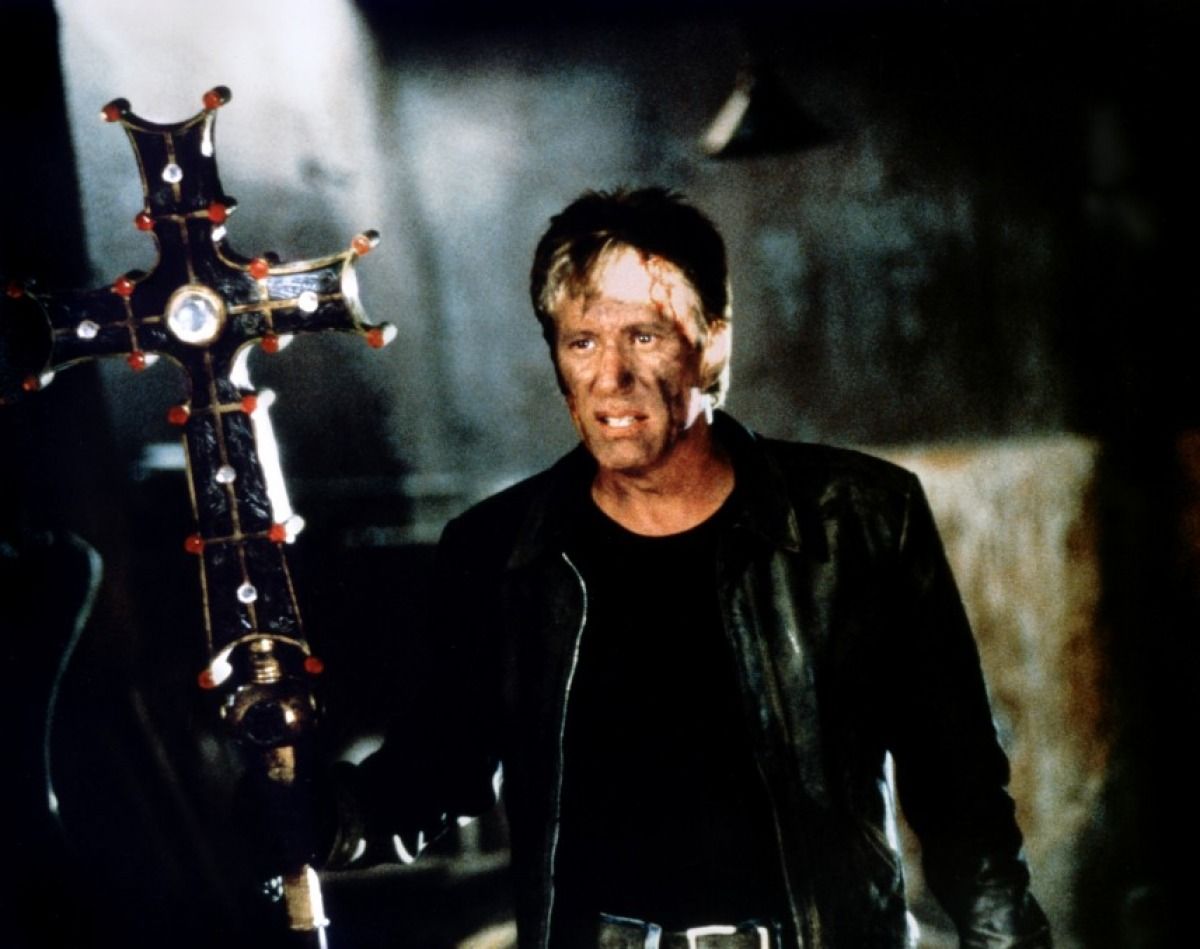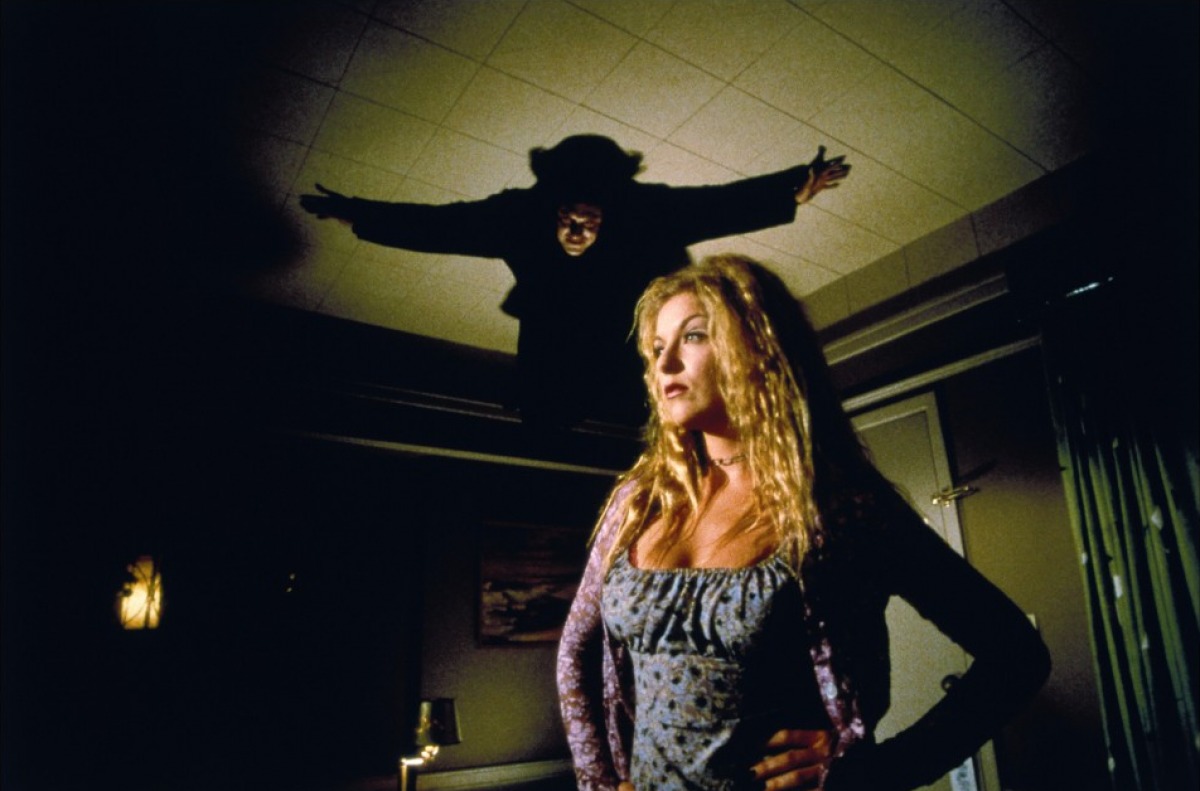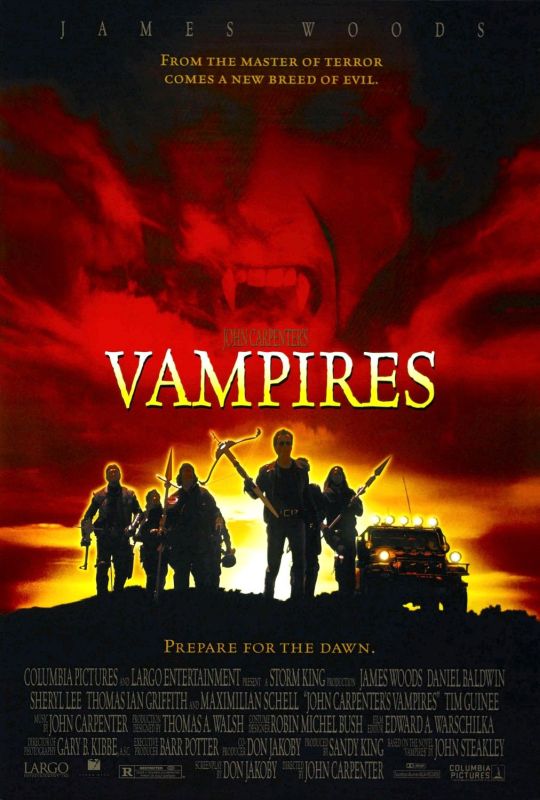Crew
Director/Music – John Carpenter, Screenplay – Don Jakoby, Based on the Novel Vampire$ (1990) by John Steakley, Producer – Sandy King, Photography – Gary B. Kibbe, Special Effects Supervisor – Darrell D. Pritchett, Makeup Effects – K.N.B. EFX Group Inc (Supervisors – Howard Berger & Greg Nicotero), Production Design – Thomas A. Walsh. Production Company – Largo Entertainment/Storm King.
Cast
James Woods (Jack Crow), Daniel Baldwin (Montoya), Sheryl Lee (Katrina), Tim Guinee (Father Adam Guiteau), Thomas Ian Griffith (Jan Valek), Maximilian Schell (Cardinal Alba), Gregory Sierra (Father Giovanni)
Plot
Jack Crow acts as a special agent for the Catholic Church, leading a team that hunts out and exterminates nests of vampires. While Crow’s team are partying at a motel after a mission, vampires come and slaughter all but all but Crow and his second-in-command Montoya. Crow believes that the assassin is the very first vampire, Jan Valek from the 14th Century, and that they were set-up from within the church. Joined by a novice priest, Crow and Montoya use a prostitute infected with Valek’s bite (and thus telepathically linked to him) to track Valek across country. Valek is attempting to locate the Berzier Cross, the necessary item for a reverse exorcism ritual that will allow him to walk in sunlight again.
It is striking how films suddenly coincide on a particular theme all at once. 1998 was filled with an amazing number of such coincidences, with two big budget asteroid collision films – Deep Impact (1998) and Armageddon (1998); two tv become reality films – The Truman Show (1998) and Pleasantville (1998); as well as a host of life after death films – After Life (1998), City of Angels (1998), What Dreams May Come (1998), Meet Joe Black (1998) and Jack Frost (1998). Add to that a duo of vampire hunter films with Vampires and Blade (1998), as well as the tv mini-series Ultraviolet (1998).
There are surprising similarities between Vampires and Blade – both feature heroes on single-minded crusades to exterminate all vampires in vengeance for a vampire’s killing of their parent(s); both pit the slayer against a master vampire; and both feature a climax where the master vampire tries to invoke an arcane ritual that involves the shedding of the imprisoned hero’s special blood. (Both films also incidentally co-star Tim Guinee). It is also interesting to note the differences between the two – Blade revelled in the kinetic delights of being a two-dimensional comic-book and all the associated poses that went with it; Vampires, although it enjoys its good share of poses too, plays itself for a greater degree of naturalism, and comes out the better of the two films.
Vampires is directed by genre veteran John Carpenter. In the early 1980s, John Carpenter was considered a major genre name with undisputed classics such as Halloween (1978), Escape from New York (1981) and The Thing (1982). While he may not have made anything as good since, Carpenter’s ensuing genre output has never been less than interesting. Carpenter has become erratic in the 1990s/00s, putting out several of his weakest films – Memoirs of an Invisible Man (1992), Village of the Damned (1995), Ghosts of Mars (2001), The Ward (2010) – and only a couple of others – In the Mouth of Madness (1995) and Escape from L.A. (1996) – which were promising but not all they could have been, while he subsequently seemed to vanish for the whole of the 2000s. The good news was that Vampires was a strong return to form for John Carpenter and one of the best films he had made in some time.

The film is never better than Carpenter’s attention-grabbing opening with the vampire hunters posed in sunglasses like Tarantino men, emerging out of the desert sun to descend on a ramshackle house; with images like the priest blessing the instruments and they then charging into battle armed with spotlights, crossbows, harpoons and machine-guns and dragging vampires out with steel winches to be incinerated in the sunlight. It is a wonderful opening that sets the mood for the film and one that throws vampire cliches up into their air by placing a unique action movie spin on them. It is without a doubt the best sequence in the film, although Carpenter does stage some memorable other set-pieces – Tim Guinee’s suspenseful venture into the vampire lair by elevator to lure the vampires out; Daniel Baldwin’s climactic rescue of James Woods. Equally, Carpenter turns in one of his finest scores in ages – a marvellous rock soundtrack filled with a twanging steel guitar.
Don Jakoby, who has written the likes of Lifeforce (1985) and Arachnophobia (1990), turns in a decent script. There is the usual McGuffin about obtaining an arcane artifact, which many vampire films seem to need to drive their plot, but this is conducted better than it is in say Blade. Don Jakoby is not above borrowing devices from elsewhere – like the tracking of the vampire by hypnotising an infected victim that is taken straight out of Bram Stoker’s Dracula (1897) – but Carpenter and Jakoby make this one of the more absorbing sections of the film. At other points, Jakoby wittily lays into much vampire cliche. “A vampire isn’t a romantic figure in a frilly shirt with a Euro-trash accent,” James Woods remonstrates Tim Guinee in a memorable throwaway line that wittily trashes Bela Lugosi and Anne Rice in one foul swoop.

James Woods should probably get some award for getting into a performance way and above the call of duty. He lets forth with a vehement and angry hard-headedness – leaping onto vampire bodies as they are being dragged out into the sunlight to repeatedly hammer stakes into their chests – that convinces you he is trying to work out something personal. Amongst the rest of the cast, Daniel Baldwin, as always, comes across as a sweaty slob who would seem more appropriately employed running a seedy X-rated video-parlour. The underrated Sheryl Lee gives another worthwhile performance. Tim Guinee also gives a performance that develops strongly throughout the film.
Most disappointing is Thomas Ian Griffith’s vampire villain. Despite Don Jakoby’s above-quoted line, Griffith is played exactly as a modern dark romantic vampire with frilly shirt, dark frock coat, long hair and pale skin that has become a cliche. Thomas Ian Griffith has all the Goth poses but there is not much more to the character than that – for the size of the role that the story throws up (killing the prime vampire), one wishes that Carpenter and Jakoby might have given the film a more substantial nemesis than this.
John Carpenter produced a disappointing sequel Vampires: Los Muertos (2002), turning directing-writing chores over to his associate Tommy Lee Wallace. Carpenter was not involved in a further sequel Vampires: The Turning (2005).
John Carpenter’s other genre films are:– Dark Star (1974); the urban siege film Assault on Precinct 13 (1976); Halloween (1978); the stalker psycho-thriller Someone’s Watching Me (tv movie, 1978); the ghost story The Fog (1980); the sf action film Escape from New York (1981); the remake of The Thing (1982); the Stephen King killer car adaptation Christine (1983); the alien visitor effort Starman (1984); the Hong Kong-styled martial arts fantasy Big Trouble in Little China (1986); Prince of Darkness (1987), an interesting conceptual blend of quantum physics and religion; the alien takeover film They Live (1988); Memoirs of an Invisible Man (1992); the horror anthology Body Bags (tv movie, 1993), which Carpenter also hosted; the H.P. Lovecraft homage In the Mouth of Madness (1995); the remake of Village of the Damned (1995); Escape from L.A. (1996); the sf film Ghosts of Mars (2001); and the haunted asylum film The Ward (2010). Carpenter has also written the screenplays for the psychic thriller Eyes of Laura Mars (1978), Halloween II (1981), the hi-tech thriller Black Moon Rising (1985) and the killer snake tv movie Silent Predators (1999), as well as produced Halloween II, Halloween III: Season of the Witch (1982), the time-travel film The Philadelphia Experiment (1984), the remake of The Fog (2005) and the reboot of Halloween (2018).
(Nominee for Best Actor (James Woods) and Best Musical Score at this site’s Best of 1998 Awards).


